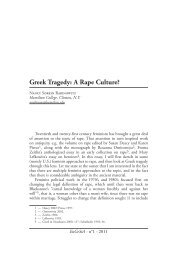Perspectives On and Of Livy's Tarpeia - EuGeStA
Perspectives On and Of Livy's Tarpeia - EuGeStA
Perspectives On and Of Livy's Tarpeia - EuGeStA
You also want an ePaper? Increase the reach of your titles
YUMPU automatically turns print PDFs into web optimized ePapers that Google loves.
174 TaRa WeLCh<br />
sabines’ habit of wearing golden armb<strong>and</strong>s. Livy ascribes this detail to<br />
common belief with the word fabula (additur fabula). Habuerint in the<br />
subjunctive further distances Livy from this belief. The erasure of agency<br />
makes the reader’s work harder: who says this? how does this affect our<br />
judgment of <strong>Tarpeia</strong>’s or Tatius’ actions? does it help to explain what precedes<br />
(the treason proper, <strong>Tarpeia</strong>’s death) or what follows? for just after<br />
this detail Livy adds a strikingly different version – Piso’s, but attributed<br />
again to an unnamed sunt qui dicant – in which <strong>Tarpeia</strong> was trying to<br />
trick (fraude) the sabines out of their weapons. again, Livy refuses to<br />
choose amongst these various points of view, <strong>and</strong> he moves on: Tenuere<br />
tamen arcem Sabini, “Whatever. The sabines were in control of the arx”.<br />
An exemplum is for the reader/viewer to interpret<br />
Livy’s presentation leaves much work for the reader to do. Roller’s<br />
study (like Chaplin’s) shows how the meaning of an example is not fixed<br />
or permanent, but changes over time <strong>and</strong> with context10 . <strong>On</strong>e core<br />
purpose of this paper is to argue that <strong>Tarpeia</strong>’s meaning is also not fixed<br />
or permanent, but exists in – <strong>and</strong> through – the exchange between teller<br />
<strong>and</strong> audience. <strong>On</strong>e cannot predict how such exchanges will develop, even<br />
how one’s own commemoration will be read.<br />
We can see the inconclusivity of exempla not only in Livy’s gr<strong>and</strong>er<br />
narrative, in which some characters use exempla to inspire their actions,<br />
others debate the applicability of exempla, <strong>and</strong> still others deny that an<br />
exemplum fits or they use an exemplum in order to argue the opposite of<br />
its apparent meaning11 . But we can see openness in interpreting an exemplum<br />
even within <strong>Tarpeia</strong>’s narrative. When Livy ascribes to Tatius the<br />
possible motive of making a moral example of <strong>Tarpeia</strong> (prodendi exempli<br />
causa ne quid usquam fidum proditori esset), the historian immediately<br />
makes such a hope moot since he tells an alternative version in which she<br />
is not a proditor; rather, she is a pro-Roman double agent12 . Piso frugi<br />
didn’t read <strong>Tarpeia</strong>’s death the way Tatius intended. We might phrase<br />
it thus: in the first motive ascribed to Tatius, Tatius wished to conceal<br />
<strong>Tarpeia</strong>’s treachery – impossible once Livy outs the concealment. In the<br />
second Tatius wishes to reveal her treachery, even make a spectacle of it –<br />
10 — Gowing 2005 offers a fruitful corollary to this idea; discussing “reading” monuments<br />
<strong>and</strong> histories in his fifth chapter (“Remembering Rome”, pp. 132-159), Gowing notes that different<br />
meanings might be invested in monuments over time. The historical referent itself (the subject of a<br />
statue or sponsor of a building) is not the final arbiter of its own meaning.<br />
11 — Chaplin 2000 throughout, especially 47-49.<br />
12 — further, McCartney 1924 notes also that the sabines, who used treachery themselves,<br />
were surely not interested in providing a moral example to posterity about treachery. McCartney<br />
looks to Livy’s fondness for paronomasia in prodendi/proditor.



